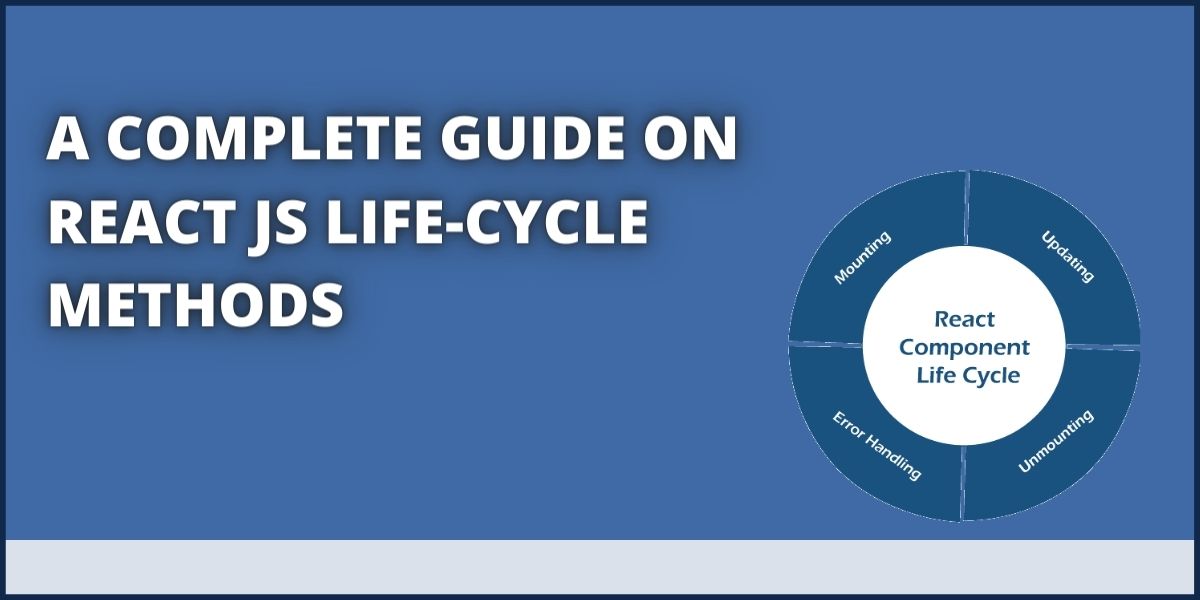Reactjs Life-Cycle Methods
- By Santosh Singh
- 18-01-2023
- Technology

Introduction
Reactjs is a javascript library for building user interfaces. It is maintained by Facebook and a community of individual developers and companies. Reactjs lets you create reusable components so that your code is easy to read and maintain. When a component is created, it goes through a series of lifecycle methods, each of which serves a different purpose. In this blog post, we will look at the reactjs lifecycle methods and what they do. We will also see how to use them effectively in your projects.
What are Reactjs lifecycle methods?
There are several lifecycle methods in Reactjs. They are:
- componentWillMount()
- componentDidMount()
- shouldComponentUpdate()
- componentWillUpdate()
- componentDidUpdate()
- componentWillUnmount()
Each of these methods is called at a different phase in the lifecycle of a Reactjs component.
The componentWillMount() method is called before the render() method is executed. This is the phase where you can initialize the state and set up any event listeners.
The componentDidMount() method is called after the render() method is executed. This is the phase where you can perform any post-rendering operations, such as setting up timers or making AJAX requests.
The shouldComponentUpdate() method is called before the render() method is executed. This is the phase where you can compare the current props and state to decide if re-rendering is necessary.
The component will update () method is called before the render() method is executed. This is the phase where you can perform any pre-update operations, such as preparing for an animation.
The componentDidUpdate() method is called after the render() method is executed. This is the phase where you can perform any post-update operations, such as cleaning up after an animation.
The component will unmount()method is called before the component is
The different types of lifecycle methods
There are three different types of Reactjs lifecycle methods:
1) Mounting: This is the first phase of the lifecycle, where the component is created and inserted into the DOM.
2) Updating: This phase occurs when the component props or state changes, and the component re-renders.
3) Unmounting: This is the last phase of the lifecycle, where the component is removed from the DOM.
When to use Reactjs lifecycle methods
There are three main phases of a React component's lifecycle:
1) Mounting: This is the phase where a component is first created and inserted into the DOM.
2) Updating: This is the phase where a component is re-rendered in response to changes in props or state.
3) Unmounting: This is the phase where a component is removed from the DOM.
Each of these phases has associated lifecycle methods that can be used to perform specific tasks at each stage.
The following table provides an overview of when to use each lifecycle method:
| Lifecycle Method | Mounting | Updating | Unmounting |
| ---------------- | -------- | -------- | ---------- |
| `componentWillMount()` | Yes | No | No |
| `componentDidMount()` | Yes | No | No |
| `componentWillReceiveProps()` | No | Yes | No |
| `shouldComponentUpdate()` | No *1* No *2* || `componentWillUpdate()` Yes *1* Yes *2* Yes *3* || `componentDidUpdate()` Yes
*1* Yes *2* Yes *3* || `componentWillUnmount()
How to use Reactjs lifecycle methods?
Reactjs offers three different ways to control the way a component renders and reacts to changes in state: props, state, and context. The most commonly used Reactjs lifecycle method is the setState() method, which is called whenever a component's state is changed. Other Reactjs lifecycle methods include shouldComponentUpdate(), componentDidMount(), and componentWillUnmount().
The setState() method is the most important of the Reactjs lifecycle methods, as it is responsible for updating a component's state in response to changes in props or state. When called, setState() schedules an update to a component's state object and re-renders the component. If you are using functional components, you can call setState() from inside the function body.
shouldComponentUpdate() is another important Reactjs lifecycle method. This method is called whenever a change occurs that could trigger a re-render of the component. If this method returns false, the component will not be re-rendered. This method is often used to improve performance by avoiding unnecessary re-renders.
componentDidMount() is called immediately after a component is mounted (inserted into the tree). This is a good place to initialize state or bind event handlers if needed.
componentWillUnmount() is called just before a component is unmounted (removed) from the tree. This is a good place to clean up any lingering event handlers or other resources.
Conclusion
The use of lifecycle methods is crucial while using React. You should be aware that working with and comprehending classes gives you a big advantage while developing great programs. Keep in mind that you will apply the most popular lifecycle methods stated in the first section of this article 95% of the time. But it doesn't imply you won't employ the other, less popular approaches. You could find these less typical approaches to be very beneficial in some circumstances when your apps start to expand.
FAQs
What are the React hooks' life cycle methods?
Reactjs lifecycle methods illustration: The lifetime of a React component includes three stages: mounting, updating, and unmounting. Each phase has distinct methods in charge of a specific step in the lifecycle of a component. Technically speaking, these methods are only designed for class-based components and not for functional components.
UseEffect: Why is it used?
To get rid of the negative impacts of employing class-based components, the use effect Hook was introduced. For instance, actions like altering the DOM, obtaining data from API endpoints, configuring subscriptions or timers, etc., may have unintended side effects.
What purposes serve React lifecycle methods?
React has built-in lifecycle methods that can be used to work with components while they are still in the DOM. When the component mounts, renders, updates, or unmounts, for instance. The render method, which is the most crucial lifecycle step, is already familiar to you.
What distinguishes the use effect from componentDidMount?
We learned from the previous query that componentDidMount does not behave the same way as the use effect hook because useEffect is invoked asynchronously after the browser has already painted the screen, whereas componentDidMount is invoked synchronously before the browser paints the screen.





